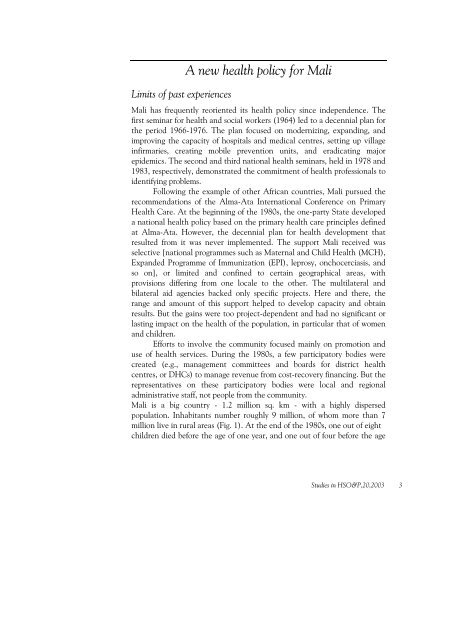Health sector reform in Mali, 1989-1996 - TropMed Central Antwerp ...
Health sector reform in Mali, 1989-1996 - TropMed Central Antwerp ...
Health sector reform in Mali, 1989-1996 - TropMed Central Antwerp ...
You also want an ePaper? Increase the reach of your titles
YUMPU automatically turns print PDFs into web optimized ePapers that Google loves.
Limits of past experiences<br />
A new health policy for <strong>Mali</strong><br />
<strong>Mali</strong> has frequently reoriented its health policy s<strong>in</strong>ce <strong>in</strong>dependence. The<br />
first sem<strong>in</strong>ar for health and social workers (1964) led to a decennial plan for<br />
the period 1966-1976. The plan focused on moderniz<strong>in</strong>g, expand<strong>in</strong>g, and<br />
improv<strong>in</strong>g the capacity of hospitals and medical centres, sett<strong>in</strong>g up village<br />
<strong>in</strong>firmaries, creat<strong>in</strong>g mobile prevention units, and eradicat<strong>in</strong>g major<br />
epidemics. The second and third national health sem<strong>in</strong>ars, held <strong>in</strong> 1978 and<br />
1983, respectively, demonstrated the commitment of health professionals to<br />
identify<strong>in</strong>g problems.<br />
Follow<strong>in</strong>g the example of other African countries, <strong>Mali</strong> pursued the<br />
recommendations of the Alma-Ata International Conference on Primary<br />
<strong>Health</strong> Care. At the beg<strong>in</strong>n<strong>in</strong>g of the 1980s, the one-party State developed<br />
a national health policy based on the primary health care pr<strong>in</strong>ciples def<strong>in</strong>ed<br />
at Alma-Ata. However, the decennial plan for health development that<br />
resulted from it was never implemented. The support <strong>Mali</strong> received was<br />
selective [national programmes such as Maternal and Child <strong>Health</strong> (MCH),<br />
Expanded Programme of Immunization (EPI), leprosy, onchocerciasis, and<br />
so on], or limited and conf<strong>in</strong>ed to certa<strong>in</strong> geographical areas, with<br />
provisions differ<strong>in</strong>g from one locale to the other. The multilateral and<br />
bilateral aid agencies backed only specific projects. Here and there, the<br />
range and amount of this support helped to develop capacity and obta<strong>in</strong><br />
results. But the ga<strong>in</strong>s were too project-dependent and had no significant or<br />
last<strong>in</strong>g impact on the health of the population, <strong>in</strong> particular that of women<br />
and children.<br />
Efforts to <strong>in</strong>volve the community focused ma<strong>in</strong>ly on promotion and<br />
use of health services. Dur<strong>in</strong>g the 1980s, a few participatory bodies were<br />
created (e.g., management committees and boards for district health<br />
centres, or DHCs) to manage revenue from cost-recovery f<strong>in</strong>anc<strong>in</strong>g. But the<br />
representatives on these participatory bodies were local and regional<br />
adm<strong>in</strong>istrative staff, not people from the community.<br />
<strong>Mali</strong> is a big country - 1.2 million sq. km - with a highly dispersed<br />
population. Inhabitants number roughly 9 million, of whom more than 7<br />
million live <strong>in</strong> rural areas (Fig. 1). At the end of the 1980s, one out of eight<br />
children died before the age of one year, and one out of four before the age<br />
Studies <strong>in</strong> HSO&P,20,2003 3











